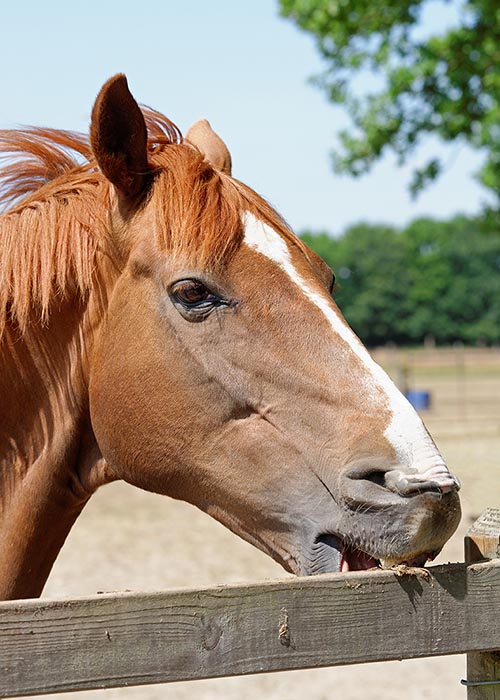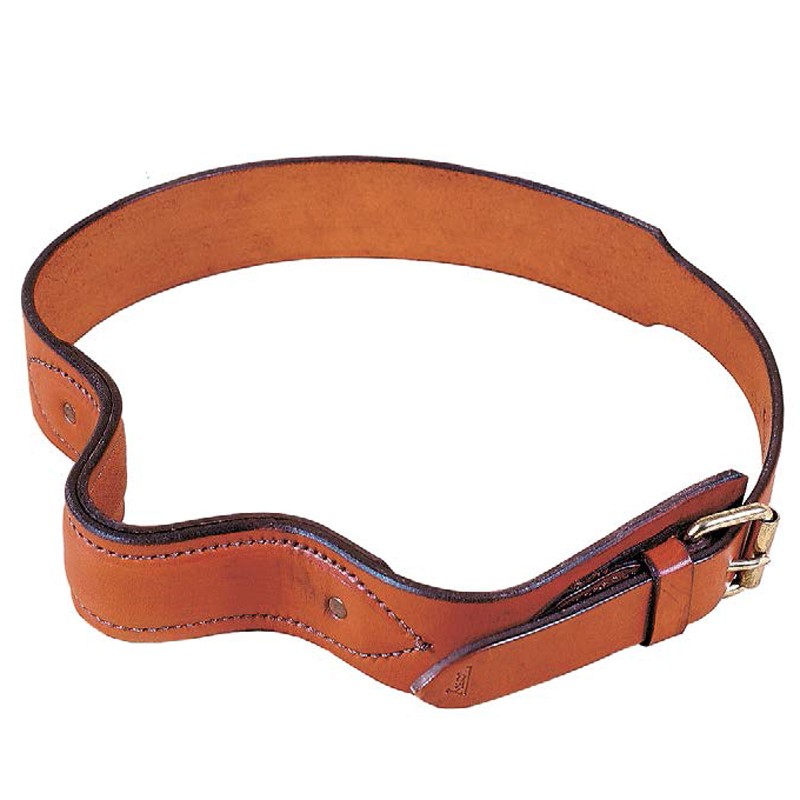If your horse cribs, you know that it is destructive to your barn and fencing, but did you know, it is also a health risk for your horse? Cribbing, also known as windsucking, is a vice where the horse clenches their teeth on to a sturdy object, such as the stall door, wooden fence rail, or bucket, and then arches their neck as they breathe in through their mouth and “suck air.” In this blog post, we take a look at some of the physical effects of cribbing while also discussing how to properly manage a “cribber” (a horse that cribs).
The Physical Effects of Cribbing

When your horse cribs, the repetitive, obsessive movements take a toll on the horse’s muscular and skeletal system. Cribbing also leads to increased wear on the horse’s incisor teeth, which means that they should have more frequent dental exams to ensure oral health.
Additionally, this repetitive behavior builds up muscles in the horse’s neck, especially those along the underside of the neck and over the poll. These muscles, when over-developed in relation to the other neck muscles, make it difficult for your horse to properly carry him or herself under saddle. They may impair the ability to work over the topline and truly connect to the bit and the rider’s hand. Horsemen and women should make adjustments to their training techniques when working with cribbers to try to build the horse’s topline and neck musculature accordingly.
There has also been research that shows horses that crib are at an increased risk for colic. Although the cause of this connection is still unclear, cribbing has been correlated with a predisposition to epiploic foramen entrapment colic. According to Dr. David Freeman, the Equine and Large Animal Surgery Specialist and the University of Florida Large Animal Surgery Service Chief, “Epiploic foramen entrapment is a type of colic where part of the small intestine becomes trapped in the epiploic foramen, a small opening in the abdomen that is high up on the right side, under the liver. The size of the epiploic foramen can accommodate approximately two adult fingers.” Epiploic foramen entrapment requires immediate surgical attention.
Managing a Horse That Cribs
There are a myriad of reasons why a horse cribs. However, it is important to note that, according to the Journal of Equine Veterinary Science, feral horses do not crib. This has led researchers to believe that cribbing is a result of human intervention. In many cases, it is a response to stress or pain, such as ulcers, lack of forage, or lack of turnout. It may also be developed from sheer boredom if your horse is not mentally stimulated. When you look to curb your horse’s cribbing, we recommend that you take a look at why your horse might be cribbing as the first course of action.
It also may be helpful to chronicle when and where your horse is cribbing. Is it primarily in the stall? Does it tend to occur before or after grain is fed? Perhaps bringing other horses into the pasture provokes anxiety? Being mindful of when your horse cribs can help you alleviate the cribbing at its most intense time. Sometimes, just changing up the horse’s routine (for instance, feeding more hay earlier in the day or bringing your horse inside first) or changing their diet (feeding more forage or adding a digestive supplement) can modify this destructive behavior.
However, once a horse begins to crib and becomes familiar with the endorphins which are released, it can be difficult to stop them… even after you have addressed the stressor. Many equestrians compare this fixation to being similar to a tobacco addiction. If this is the case, as it often is, you will need to turn to cribbing deterrent practices and products.
To manage cribbing, try to make sure that your horse has constant access to forage. Many horses will prioritize eating over cribbing, so if they have free choice hay to eat, it will minimize the cribbing behavior. Other horses will choose cribbing over eating and lose weight so it is important to have grass or high-quality hay to entice them to eat and not crib. Ideally, turn your horse out on green pastures where they can graze to their heart’s content. If pasture is not readily available, consider using a slow feed hay net, such as The NibbleNet, to slow your horse’s rate of consumption and ensure that they can eat all day long. If you have an easy keeper or an overweight horse, you can feed a lower quality forage in higher quantities; this keeps your horse mentally stimulated when they are in the stall or dry lot.
You may also want to experiment with different feeding practices. For example, horses who are sensitive to sugar may show increased digestive distress, and therefore crib more frequently, if fed sweet feed or a hay high in non-structural carbohydrates (NSCs). Paying closer attention to your horse’s triggers can help to manage cribbing in a more holistic way. A study by Carissa Wickens and Camie Heleski in 2010 mentions that horses that crib can often be labeled as “hard keepers.” This is a result of the increased energy requirements of cribbers. Many horse owners chose to feed more grain to combat these energy needs. However, this can be a vicious cycle and actually cause your horse to crib more. Generally speaking, many horse health care professionals recommend a diet high in forage and lower in concentrates (grain), when formulating a diet plan for a cribber.
Additionally, stall toys, such as Likit Horse Toys and Horseman’s Pride Jolly Balls, can give your horse something else to focus on. In fact, the Likit Tongue Twister was clinically proven to reduce cribbing activity by 27% in the Cornell University study performed by Katherine Houpt, VMD, PhD in 2011. By distracting your horse, you can hopefully limit their abnormally fixated behavior (cribbing).
There are a number of products on the market that are designed to stop your horse from cribbing. Some of these are physical barrier products while others discourage your horse from chewing on certain surfaces.
One of the most commonly used pieces of equine equipment to stop a horse from cribbing is a cribbing collar. Cribbing collars prevent your horse from cribbing while still allowing them to breathe, eat, and drink normally. As a horse cribs, the muscles of the neck expand and flex. Cribbing collars work by impairing the natural range of motion of the horse’s neck muscles, making it difficult for them to flex their neck and suck air (or “wind suck”) while causing pressure and discomfort to the throatlatch. This prohibits the release of endorphins from the action.
Tory Leather French Style Cribbing Strap
A cribbing collar will discourage cribbing by making it difficult for your horse.
Cribbing collars must be properly sized and adjusted to work, lying snugly across your horse’s throat latch. Start by adjusting the collar so that you can fit two fingers comfortably between the throatlatch and your horse’s throat, and then carefully watch your horse for signs of cribbing behavior. Carefully tighten the strap as needed, making sure that it does not impair your horse’s ability to eat or drink normally. Cribbing collars that are too tight can damage the windpipe and your horse’s blood vessels, as well as causing swelling and skin irritation. Please ask a member of our sales team or an experienced equestrian if you have any questions regarding the correct fit of the cribbing collar. The tight fit of the collar, paired with long term usage, may result in rubs or hair loss occurring. To minimize the effects, we recommend a cribbing strap pad or cover, like the Schutz Brothers Dare Cribbing Collar Fleece Cover, to protect your horse’s skin, coat, and mane. Cribbing collars are only effective while your horse is wearing them, they will not teach your horse not to crib or change this destructive habit.
Sometimes, wearing a cribbing collar is not effective or practical, such as in the case of turnout with other horses. In these instances, treating the buckets, fenceline, wall, or whatever your horse is cribbing and chewing on with a foul-tasting and -smelling product may deter your horse from latching on the surface. Consider the surface when you choose a cribbing deterring spray or ointment, for instance, Farnam No Chew repels moisture, making it an excellent choice for exterior applications on trees or fencing.
Farnam No Chew Spray
The bitter taste of this spray will deter your horse from chewing or cribbing on applied surfaces.
It is important to realize that cribbing is often a lifetime habit for horses. However, it can be easily managed when you have knowledge about this common equine vice. For the health of your horse and the integrity of your barn and fencing, it is essential to find the horse management practices which modify your horse’s cribbing behaviors.
Cribbing is a destructive stable vice that also has health implications for your horse. If your horse cribs, stay calm. With proper management and the right equine equipment, we can help you minimize or eliminate cribbing from your horse’s daily life. If you have any questions regarding the products which deter cribbing that we carry or would like assistance choosing the best cribbing collar for your horse, we encourage you to speak to a member of our friendly and highly trained sales staff.



I have tried all of the products listed in this article with my horse that has had this difficult vice, all of his life. He is 24 years young now and although seems healthy, his front teeth are wearing substantially, and I’m sure he will be experiencing problems soon as a result of this. I need to add that I love my horse and will do whatever it takes to keep him comfortable all of his years.
However, it should also be noted that cribbing or wind sucking can also be a genetic inheritance, as my horse’s sire apparently had this same addiction. It may NOT be easily managed and potential horse owners should be also fore-warned that it may NEVER be “controlled or stopped”. This may be ok if the horse is guaranteed boarded at the home of the owner. IF the owner ever had to board the cribber, it may be extremely difficult to find a stable that will allow the horse on the premises. As an owner of a horse who wind sucks, I have first-hand knowledge and believe it’s important to report ALL of the information including that which I am sharing, so as to give a potential horse owner ALL of the facts before they may consider the purchase of a horse with this vice.
Thank you.
I had a cribber 14 years . Yes I tried the straps but after the leather broke , I threw it away . I researched along time and tried many tummy supplements …. probiotics , yeast ,etc . Finally I used yea sacc and it wasn’t the first time but it worked . My horse hasn’t cribbed in over a year … I watch his sweet intake and keep things very bland .